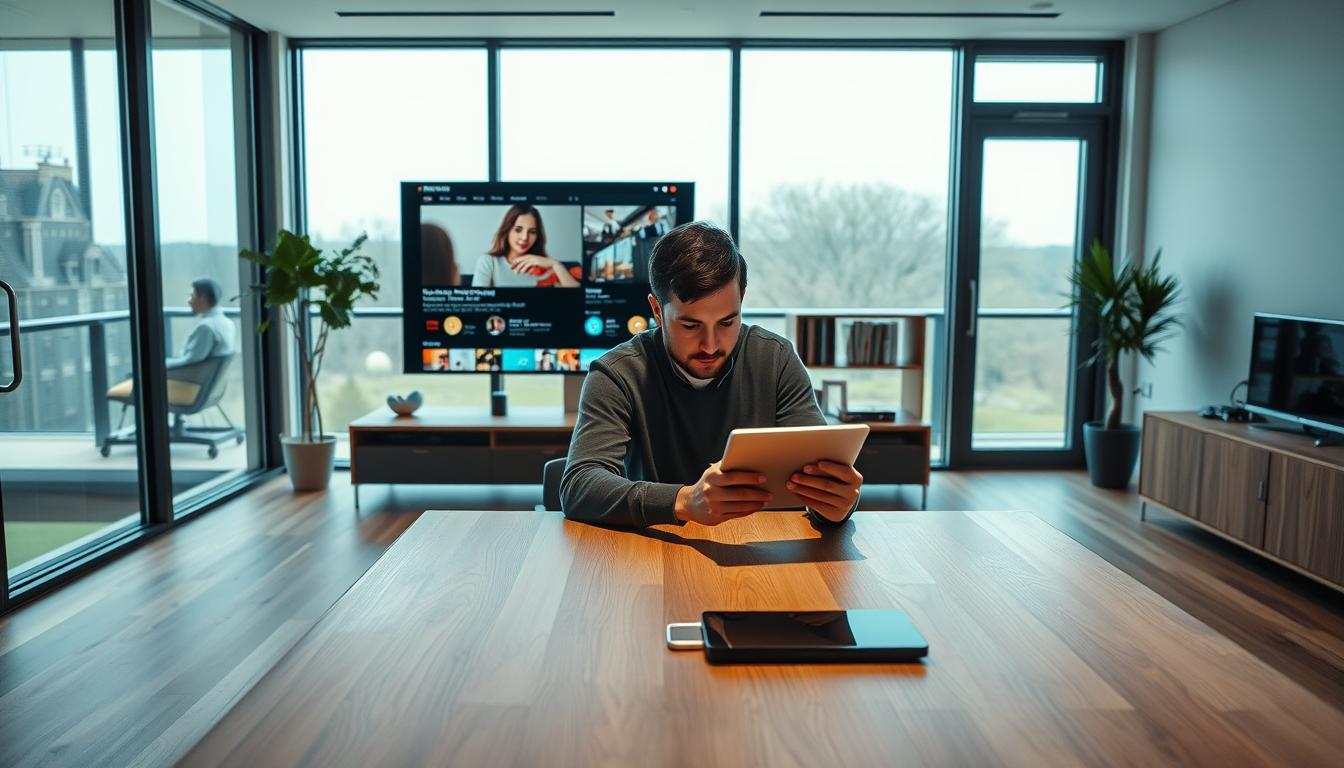Now Reading: News & Analysis: A Guide to [Relevant Topic]
- 01
News & Analysis: A Guide to [Relevant Topic]
News & Analysis: A Guide to [Relevant Topic]
In today’s fast-paced world, it’s vital to critically consume news. Social media and online publications have changed how we get information.

The amount of information out there is huge. It’s hard to tell what’s credible and what’s not. This guide will help you improve your news literacy. It will show you how to handle the complex media world.
Learning to critically evaluate news & analysis is key. It helps you make smart choices and stay updated in a world where info changes fast.
Key Takeaways
- Critical news consumption is crucial in today’s information age.
- Enhancing news literacy helps in distinguishing credible sources.
- Understanding news & analysis is key to making informed decisions.
- This guide will walk you through the process of critically evaluating news.
- Improving your ability to navigate the complex media landscape.
The Current State of News & Analysis
The world of news and analysis has changed a lot in recent years. This change is thanks to new technology and how people now get their news. Most people get their news from digital sources.
The Evolution of News Media in the Digital Age
The news industry has grown a lot. It has moved from old print media to digital formats. This change makes news more available and up-to-date.
From Print to Digital: Key Transformations
The move from print to digital has brought big changes. News can now be updated instantly. It also includes videos and podcasts.
The Rise of 24/7 News Cycles
Now, news is available all the time. News outlets can cover events as they happen. This means news organizations must be quick to report.
The Changing Landscape of News Sources
There are now many places to get news. Online sites, social media, and blogs are all options. But, it’s harder to know which sources are trustworthy.
Challenges Facing Modern News Consumers
Getting news today can be tough. There’s too much information, and it’s hard to know what’s true. To deal with this, people need to think critically and understand media.
Why Critical News Consumption Matters Today
In today’s digital world, it’s more important than ever to consume news critically. How we get our news shapes our view of the world and our choices.
The amount of information out there is huge. Information overload is a big problem. It’s hard to know what’s really important.
The Information Overload Problem
The digital age has given us a lot of news and info. With social media and online news outlets, we’re bombarded with info. Here are some big issues with information overload:
- Many sources fight for our attention
- It’s hard to know if sources are trustworthy
- We might miss important info in the noise
The Real-World Impact of Misinformation
Misinformation can really hurt us. It can sway elections and cause social unrest. It’s key to be aware of these risks and to think critically about the news.
How Media Literacy Empowers Citizens
Media literacy helps us understand the news better. It lets us make smarter choices and join in public talks more. Key parts of media literacy are:
- Knowing the difference between news, opinion, and analysis
- Spotting bias and false info
- Using tools to check facts
Improving our media literacy skills helps us deal with the complex media world. We become more informed and active citizens.
How to Identify Reliable News Sources
In today’s digital world, it’s key to know the difference between good and bad news sources. With so much info out there, learning to check sources is vital.
Evaluating a News Organization’s Credibility
Checking if a news group is trustworthy involves a few important steps. First, look at who owns and funds them. This can show if they have any biases.
Ownership and Funding Models
News groups that are open about their money and who they work for are usually more trustworthy. Make sure to check who supports them and if they have any conflicts of interest.
Editorial Standards and Corrections Policy
Good news groups have clear rules for editing and a way to fix mistakes. They should also clearly mark opinion pieces. This shows they care about being right.
Reputation and Awards
Seeing if a news group is respected and has won awards can tell you a lot. Look into their reputation in the journalism world and any awards they’ve gotten.
Warning Signs of Unreliable News Outlets
Knowing the signs of bad news sources can help you avoid false info. Look out for a lack of sources and unclear information.
Lack of Attribution and Sources
Good news stories always tell you where they got their info. Be careful of stories that don’t.
Excessive Sensationalism
News groups that focus too much on shocking headlines might be more about getting clicks than telling the truth.
Poor Website Design and Questionable Ads
A professional-looking website and good ads can mean a news group is serious. Watch out for sites with too many weird ads or a bad look.
Tools for Verifying News Source Credibility
There are tools to help check if news sources are trustworthy. Fact-checking sites and browser extensions can spot fake news. 
By using these tools and paying attention to what we’ve talked about, you can choose better news sources.
Distinguishing Between News, Opinion, and Analysis
The lines between news, opinion, and analysis often blur. It’s key for consumers to learn to tell them apart. In today’s complex media world, knowing the difference is vital for making smart choices.
Characteristics of Objective News Reporting
Objective news focuses on verifiable facts and balanced views. Look for these signs to spot it:
Identifying Factual Statements
Factual statements are the heart of objective news. They can be checked with evidence and aren’t swayed by personal views. When you read an article, find the facts and separate them from opinions.
Recognizing Balanced Presentation
A balanced report gives fair space to various views on an issue. It doesn’t mean every view is equally important. It shows the issue’s complexity by presenting different sides.
How to Spot Opinion and Commentary Pieces
Opinion and commentary pieces share the author’s view or interpretation. Here’s how to spot them:
Language Clues and Subjective Statements
Opinion pieces often use emotive language and value judgments. Watch out for articles with loaded language or claims without proof.
Author Bylines and Section Placement
Many publications clearly mark opinion and commentary with the author’s byline. They’re often in sections like “Opinion” or “Editorial.” Pay attention to these signs when reading.
Understanding News Analysis and Its Value
News analysis dives deep into events, explaining their context. It helps readers grasp the news’s meaning and importance. It’s especially useful for complex topics that need detailed explanation.
By knowing the difference between news, opinion, and analysis, we can better understand current events. This helps us make more informed choices.
Recognizing Bias in News & Analysis
It’s key to spot bias in news to make smart choices. Today’s media world is complex. Knowing about bias and its effects on news is vital.
Common Types of Media Bias
Media bias shows up in many ways. It changes how we see news. The main types are:
Selection Bias: What Stories Get Covered
Selection bias picks some stories over others. This can distort what we know about big issues. It gives us a partial view of what’s happening.
Framing Bias: How Stories Are Presented
Framing bias shapes how we see a story. The same event can be seen in a good or bad light. This greatly affects what we think.
Word Choice and Tone Bias
The words and tone in news can also show bias. The language used can push a certain view. This can change how we feel about things.
How to Detect Bias in Reporting
Spotting bias in news needs a careful eye. Here are ways to find biased reporting:
- Analyzing Headlines for bias hints: Headlines often show the story’s tone.
- Examining Source Selection Patterns: Who is quoted can show bias.
- Identifying Missing Perspectives: Good reports have many views.
Strategies for Consuming News Across the Political Spectrum
Reading news from all sides is crucial. It helps avoid biased views. This way, we get a full picture of what’s happening.
Knowing about bias and looking for different views helps us make better choices. It keeps us informed with a balanced view.
Essential Fact-Checking Techniques for News Consumers
With more misinformation around, fact-checking is key. It’s important to check if the news we read is true. This section will show you how to spot the truth in today’s media.
Using Professional Fact-Checking Resources
Using sites like Snopes, FactCheck.org, and PolitiFact is a smart move. They check if what public figures say is true. This helps us know what to believe.
How to Cross-Reference Information Effectively
Checking information by looking at different sources is crucial. Here’s how to do it well:
- Look at various sources with different views.
- See if different places agree on the same thing.
Finding Primary Sources
Finding primary sources is important. They give us direct info on a topic. Examples include original studies, government reports, and direct statements from people involved.
Comparing Coverage Across Multiple Outlets
Seeing how different news outlets report the same story can show biases. It helps us understand the whole picture and spot false info.
Verifying Statistics and Data Claims
Statistics and data are often used in news. But they can be wrong if not used right. Here’s how to check them:
- Look at the original study or data.
- Know the context and limits of the data.
Checking Original Research Sources
To check data, look at the original research sources. This lets you see how the study was done and its findings.
Understanding Context and Limitations
It’s important to know the context and limits of data. This includes the source, how it was gathered, and any biases.
By using these fact-checking tips, we can better tell true news from false. This makes us more informed and critical thinkers.
Navigating Headlines and Click-bait Content
Click-bait content has made it key to know how to read headlines. Today, headlines decide if we read a story or not. It’s vital to think critically when we read the news.
Anatomy of Misleading Headlines
Misleading headlines use sensational words to catch our eye. They might make exaggerated claims or use emotional appeals. Knowing these tactics helps us be more careful.
Techniques to Look Beyond Sensationalism
To get past sensational headlines, we need to check facts. We should look for reliable sources and watch for biases. This way, we understand the news better.
How Headlines Shape Perception Before Reading
Headlines can change how we see a story before we read it. A misleading headline can lead to wrong ideas. But a clear headline gives a good summary. Knowing this helps us read with a critical mind.
How to Follow Breaking News Responsibly
In today’s fast world, keeping up with breaking news needs careful thought. News spreads quickly online, offering updates but also risks of false information.
Understanding the Evolving Nature of Breaking News
Breaking news isn’t just on TV anymore. Social media and online news have changed how we get news. Now, we get updates fast, but it’s harder to know what’s true.
Key characteristics of breaking news include:
- Rapidly unfolding events
- Initial reports often lacking full context
- Multiple sources reporting simultaneously
Strategies for Verifying Early Reports
It’s key to check early news reports for accuracy. Here are ways to do it:
Cross-referencing information across multiple trusted sources helps confirm reports. Check if other reliable news outlets are saying the same thing.
Identifying Official vs. Unofficial Sources
Knowing the difference between official and unofficial sources is crucial. Official sources, like government statements or direct reports, are usually more reliable than social media posts from unknown people.
Recognizing Preliminary vs. Confirmed Information
It’s important to know the difference between early reports and confirmed news. Early reports might be wrong or incomplete. Confirmed news has been checked by many sources or official channels.
Creating a Breaking News Consumption Plan
To follow breaking news wisely, having a plan is helpful. This includes:
- Identifying trusted news sources
- Setting up news alerts from reliable organizations
- Regularly checking fact-checking websites
Evaluating In-Depth News Reports and Investigations
It’s important to check if news reports are trustworthy. Investigative journalism gives us deep insights into big issues. This helps us understand complex topics better.
Key Components of Quality Investigative Journalism
Good investigative journalism has a few key parts. These include source diversity and transparency, and strict documentation and evidence standards.
Source Diversity and Transparency
A reliable report uses many sources. It also shows how it gathered information. This lets readers see why the report is trustworthy.
Documentation and Evidence Standards
Top-notch journalism uses solid evidence. This can be data, expert opinions, and more.

Assessing Methodology and Research Quality
When we read in-depth reports, we should check how they were made. We look at data collection methods and expert consultation and peer review.
Data Collection Methods
Good reports explain how they got their data. This lets readers spot any issues.
Expert Consultation and Peer Review
Reports that get checked by experts are more reliable. This step makes sure the report is well-made.
Recognizing Conflicts of Interest in Reporting
It’s key to know if there are any conflicts of interest in reports. We should look at who wrote the report and if they might be biased. For tips on checking complex reports, see evaluating crypto project whitepapers.
By paying attention to these points, we can better judge the trustworthiness of in-depth news and investigations.
Social Media News Consumption Strategies
Getting news from social media needs a careful approach. It’s important to know how to use these platforms well. This helps us get the most out of them.
Benefits and Pitfalls of Social Media as a News Source
Social media gives us quick updates and many views. It’s great for news. But, it also has problems like fake news and “echo chambers”.
To get the good without the bad, we need to watch out for these issues.
How to Verify Information from Social Platforms
It’s key to check if social media news is true. Here are some ways to do it:
Checking Account Authenticity
Make sure the news comes from real accounts. Look for official badges and check if the account is trustworthy.
Tracing Information to Original Sources
Find where the news first came from. This helps confirm if it’s true. Check if it’s from reliable news sites or sources.
Using Reverse Image Search Tools
Reverse image search tools can spot fake images. They help us make sure the pictures are real.
Managing Algorithm-Driven News Feeds
News feeds can sometimes only show us one side. To see more, adjust your settings. Follow different news sources and look for various views.
By using these tips, we can make our social media news better. It becomes more varied and accurate.
Approaching International News with Cultural Context
International news is complex and requires careful thought. It covers many different cultures. Understanding the cultural context of news is key.
Understanding Cultural Biases in Global Reporting
Cultural biases shape how we see and report news. Knowing about these biases helps us understand news better. For example, a story about politics can mean different things to people from different cultures.
Key factors to consider:
- Cultural norms and values
- Historical context
- Social and political climate
Navigating Translation Issues and Terminology Differences
Translation problems can make international news hard to grasp. Words and meanings can get lost in translation. Using reliable sources that explain these issues can help.
Some strategies include:
- Cross-referencing with multiple sources
- Seeking out news agencies with strong translation practices
- Being cautious of overly simplistic or sensational translations
Finding Diverse International News Perspectives
Looking for different views on international news can deepen our understanding. It means exploring news from various places and cultures.
Benefits of diverse perspectives:
- Broadened understanding of global issues
- Exposure to different analytical frameworks
- Enhanced critical thinking skills
Creating Your Personalized News Consumption System
With so much news out there, finding a way to pick what’s important is key. A personalized news system lets you focus on what you care about. It helps you avoid getting lost in too much information.

Building a Balanced News Source Portfolio
A good news diet has local, national, and international sources. This mix gives you a full view of what’s happening worldwide.
Local, National, and International Sources
Local news tells you about your community. National and international news give you a bigger picture. For example, a study on media habits is in this research paper.
Specialty and Niche Publications
Specialty publications dive deep into topics like tech or health. Adding these to your news mix can really help you understand more.
Setting Up Effective News Aggregators and Alerts
News aggregators and alerts make getting news easier. They let you pick what you want to see, saving time and effort.
Customizing News Apps and Feeds
Many news apps let you choose what you see first. This helps you manage the news and focus on what’s important.
Creating Topic-Specific Alerts
Topic-specific alerts keep you updated on what you’re interested in. It’s great for staying on top of big news or new developments.
Establishing Healthy News Consumption Habits
It’s important to keep a balance with news. Set limits on when you check news to avoid feeling overwhelmed.
By using these tips, you can make a news system that works for you. It’s both useful and easy to keep up with.
Sharing Media Literacy Skills with Others
Sharing our media literacy skills helps us all better understand the news. It’s not just about knowing ourselves. It’s also about teaching others to think critically about news sources.
How to Discuss News Critically with Family and Friends
Talking about news with family and friends needs care. It’s key to make sure everyone feels safe to share their views.
Starting Productive Conversations
To kick off a good talk, ask questions that open up the topic. This lets others share their thoughts and deepens the conversation.
Addressing Misinformation Respectfully
When talking about wrong information, be kind. Share reliable sources to back up your points. Stay calm to avoid making others defensive.
Resources for Teaching News Literacy
There are many tools and programs to teach news literacy. These range from educational materials to community classes.
Tools for Parents and Educators
Parents and teachers can find online tools and lesson plans. These are made for different ages and help teach media literacy.
Community Programs and Workshops
Community programs and workshops are great for learning news literacy. They offer hands-on experiences and interactive lessons.
Promoting Critical Thinking in Online Discussions
To boost critical thinking online, encourage people to question and seek sources. This improves the quality of online talks.
Becoming an Empowered News Consumer in the Digital Age
In today’s complex media landscape, becoming an empowered news consumer is key. This guide helps you learn to critically evaluate news & analysis. It’s vital for navigating the digital age.
Empowered news consumers know how to check facts, spot bias, and tell news from opinion. They look for different views and watch out for false info.
To stay informed, be proactive and careful in what you read. This way, you’ll make better choices and join in on important discussions.
Being an empowered news consumer is a journey. Always be alert, keep learning, and welcome new views and facts.
FAQ
What is the importance of critical news consumption in today’s digital age?
Critical news consumption is key today. It helps us sort through lots of info. We learn to trust good sources and make smart choices.
How can I identify reliable news sources?
Look at a news site’s credibility. Check who owns it and how it’s funded. Also, see if it has a good reputation.
Watch out for sites that don’t give sources, are too sensational, or look bad.
What are some common types of media bias, and how can I detect them?
Media bias comes in many forms. There’s selection bias, framing bias, and word choice bias. To spot it, look at headlines closely.
See who they choose to quote and if they leave out important views.
How can I verify information from social media platforms?
Check if social media accounts are real. Look for original sources of info. Use tools to reverse image search.
Be wary of info that seems too good or bad to be true. Make sure it’s backed by solid sources.
What are some strategies for consuming news across the political spectrum?
To get news from all sides, look for different views. Know your own biases. Try to see things from other angles.
Read various sources before you decide what you think.
How can I create a personalized news consumption system?
Build a mix of news sources. Use apps and alerts to get news your way. Make sure you’re getting a balanced view.
Customize your news feeds. Set up alerts for topics you care about.
What are some essential fact-checking techniques for news consumers?
Good fact-checking starts with using trusted sources. Cross-check info and verify stats. Look up original research.
Understand the context and limits of the info. Be careful of unverified claims.
How can I share media literacy skills with others?
Talk about news with family and friends. Teach others about news literacy. Encourage critical thinking online.
Use tools for parents and teachers. Join community programs and workshops. Help others learn to critically consume media.












